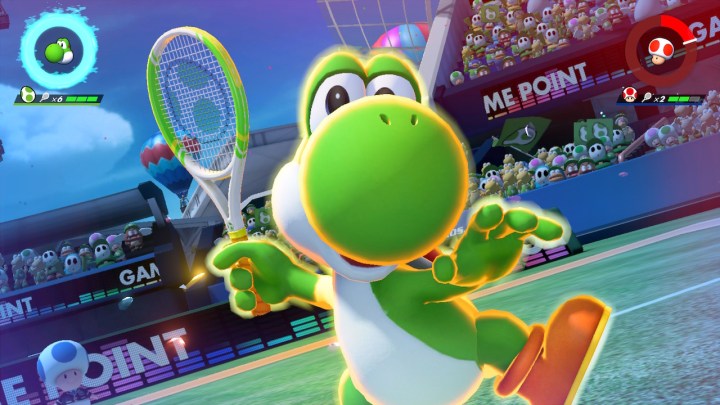
Tennis with a combat twist. That’s the best way to describe Mario Tennis Aces for Nintendo Switch. Yes, it’s tennis, but simply being good at tennis games isn’t enough to come out victorious. To be great, you must master an array of critical and devastating shot types, play mind games with your opponent, and always be on the look out for the unexpected.
Play Adventure Mode First
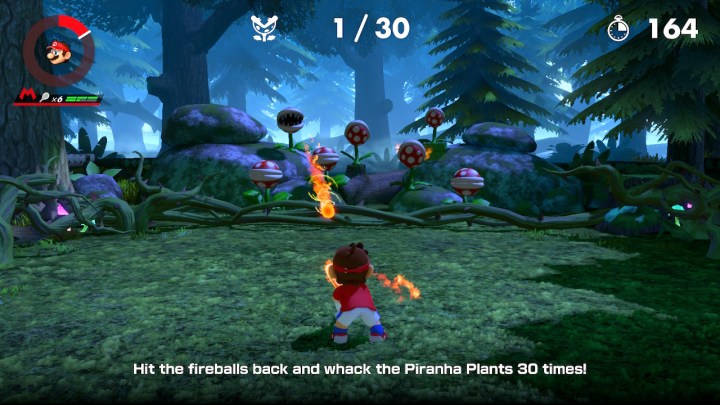
Right off the bat, the Mario Tennis Aces shoots you into Adventure, the story mode that sees Mario retrieving power stones to save Luigi. Not only does Adventure provide a series of remixed tennis challenges, but it’s the single best way to learn and master different shots, develop strategies, and prepare yourself for the gauntlet of online matches. Consider it an extended tutorial, and a must-play if you want any hope of winning in competitive online matches, or against the most difficult AI.
Learn the basic moves

Still, if you just want to play with friends either locally or online, here’s a brief rundown of what you learn in the story mode.
The eight shot types
- Topspin (A) – The basic and fastest shot.
- Slice (B) – Although a slower shot by default, the slice curves in the air and takes a sideways leaning hop when it lands.
- Lob (X + Up) – High arcing shot that lands softly and typically near the back of the court.
- Drop (X + Down) – Another slow shot, but this is the opposite of a lob, as it descends quickly and lands just over the net.
- Flat (Y) – A shot that breaks up the back and forth of topspin and slice shots, this shot moves fast in the air on a constant trajectory. It doesn’t bounce as high as the slice or as fast as topspin shots, giving your opponent less time to get to it.
- Trick shot (right stick) – Covers about half the length of the court, moving the right stick left or right tells your character to vault quickly to get to a ball that’s out of reach. Trick shots don’t need an additional button press unless you are using one to block a zone shot.
- Zone shot (R or ZR) – After storing energy, you’ll sometimes see a sparkling star icon as the ball travels to your side of the court. Get under the icon and press R or ZR to hop in the air and manually aim this rapidly moving shot.
- Special shot (L or ZL) – If you’re energy meter is sizzling white, you can press L or ZL with the ball on your side of the court (you don’t really have to be close to it) to execute your character’s special shot. This shot moves even faster than a zone shot and is ridiculously challenging for your opponent to return. It depletes the entirety of your energy meter.
On serves, you can use either topspin, slice, or flat shots. Press the button once to toss the ball, and then press it again as it falls down. The further you let the ball fall before hitting it, the faster your serve. The timing is pretty easy to master and you’ll soon see “good” flash across the screen on most serves.
Learn to charge your energy meter
Your energy meter is essential to executing zone shots and special shots. But it doesn’t fill just because you have a long rally going. To fill the green circle in the upper-left hand corner of the screen, you need to put a little something extra on your shots. Before the ball gets to your racket — and ideally before the ball even leaves your opponent’s side of the court — hold down the button of the shot you want to execute. Most often this will be topspin or slice. The result is a faster shot and a boost of energy in the meter. You can also fill your energy meter by completing trick shots. Always, and we mean always, work towards filling your energy meter. It’s essential, as you will soon find out.
Zone Shots are confusing, and a key to victory

There will come a time, probably quickly, when you get annoyed and perplexed by zone shots. You’ll think: “My energy gauge is full, where’s the sparkling star,” or “how come they keep getting zone shots?” The reason zone shot opportunities show up or don’t show up on screen is one of the most confusing aspects of Mario Tennis Aces.
In our experience, zone shot opportunities arise most often after you’ve hit a successful charge shot back to your opponent and you have energy in your meter. On the flip side, zone shot opportunities for your opponent come up after they hit a charge shot and you are unable to return it with a powerful shot of your own. That’s why working towards filling your energy gauge is always a good move — it increases your opportunity for Zone Shots.
How to execute a Zone Shot
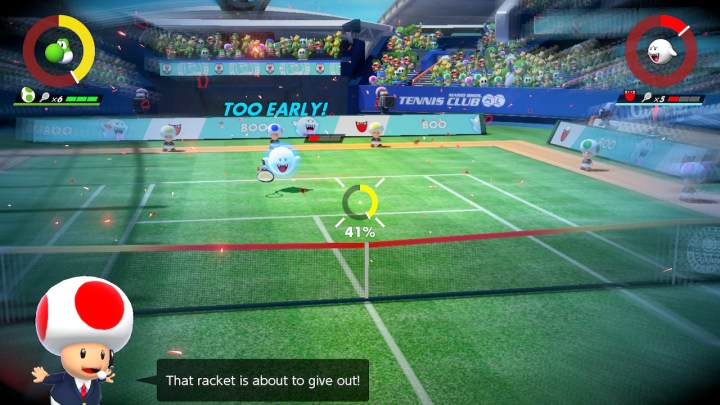
Zone Shots are tricky to get the hang of. When you see the star, race over to hit and press R or ZR. You jump in the air, time slows down, and you are in first-person view with a tracer in the center of the screen. You have to aim the tracer, but you don’t have a lot of time. You’ll notice around the aimer, a number ranging 1-100 declines quickly — that’s your energy gauge. The quicker you aim and fire your shot, the less energy you lose, so don’t dilly dolly. If your meter reaches zero — and stays there for a moment — before firing your shot, the ball will move high and slow across the court, basically teeing your opponent up for an easy return instead.
So where should you aim your zone shot? The clearest and safest choice is on the opposite side of the court from where your opponent currently stands. Doing this will make them have to think very quickly and use a trick shot to get to the ball in time. Aim towards the edges of the court, whether that be in the back or front corners, giving your opponent little space to work with. Or, if your opponent is closer to the net, aim it over their head for a surefire point.
How to block Zone Shots
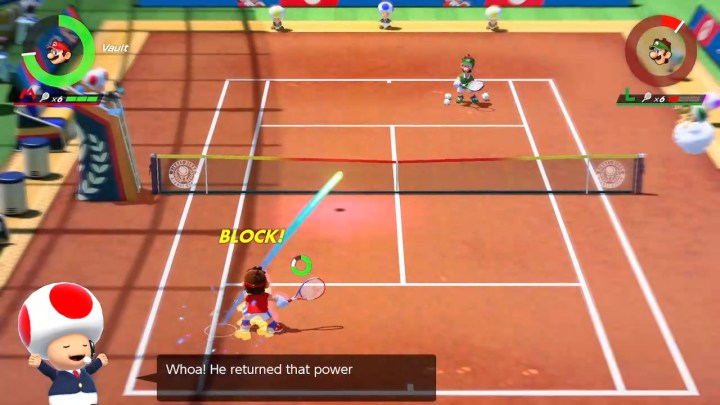
Firing off a zone shot is fun and often leads to a point, but being on the receiving end of one is daunting.
To block a zone shot, you need to do multiple things right, none of which are particularly easy. First, you should slow down time as soon as you see your opponent’s racket move in mid-air. To do this, press R or ZR. Slowing down time depletes your energy gauge, so don’t do this too early or for too long, but it’s a necessity in order to see where the ball is headed.
As we mentioned, aiming zone shots on the opposite side of the court is safest, so expect the brunt of your opponent’s zone shots to follow the same strategy. That means you’ll have to slow down time and then, to get to the ball, use a trick shot. Trick shots also slow down time, so after pressing R or ZR, let go and flip the stick.
When in front of a zone shot, timing is key. You have to wait until the ball is right on your racket before you press a shot button, otherwise a prompt will say “too early.” Mistimed blocks come off the racket weakly, whereas successful blocks come off with a spring. We found that waiting until it feels just a tad late is actually when you should press the button to return a zone shot.
Keep in mind, even the best players won’t always be able to get to zone shots. If your opponent places them in corners or on the lines and you are way on the other end of the court, you will have a very tough time returning it. Keep that in mind when positioning your character on the court.
Bust(ing)ed rackets
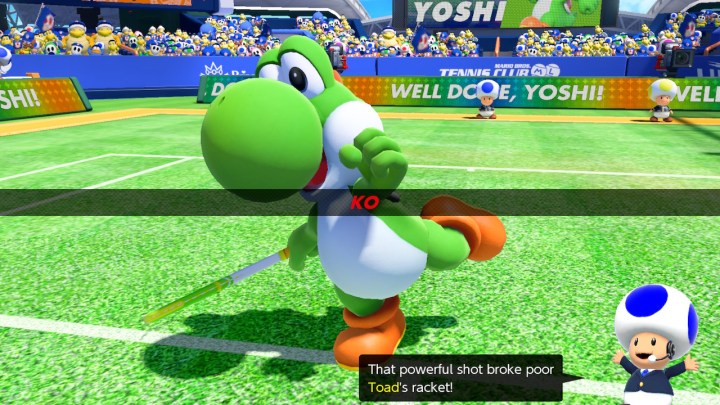
As just mentioned, failing to properly time a Zone Shot will earn you a “too early” prompt — and there’s more bad news. They damage your racket.
If your racket takes too much damage, you are knocked out and automatically lose the match, no matter the score. So, think carefully before attempting to block zone shots.
If you are firmly in the lead, but your racket has taken heavy damage already, it’s probably best to concede the point to your opponent. Don’t try to be a hero when you can afford to lose a point, or else you might get knocked out despite playing a better game than your opponent. If your racket is weak and you fail a block, it will break and you’ll cede the point.
Also, be on the lookout for opponents who target your racket. Yes, we said the best option is to aim zone shots away from your opponent, but sometimes people will try to break your racket, especially if they know you don’t have block timing down. If you aren’t good at blocking yet and your opponent tries to hit a zone shot directly at you, resist the impulse to try and return it.
On the other side of this, you should absolutely try to bait your opponent into a “too early” shot, at least early on. If you learn they aren’t good at blocking, you can flip your strategy and aim zone shots right at them to go for the KO.
Master the Trick Shot to improve your defense
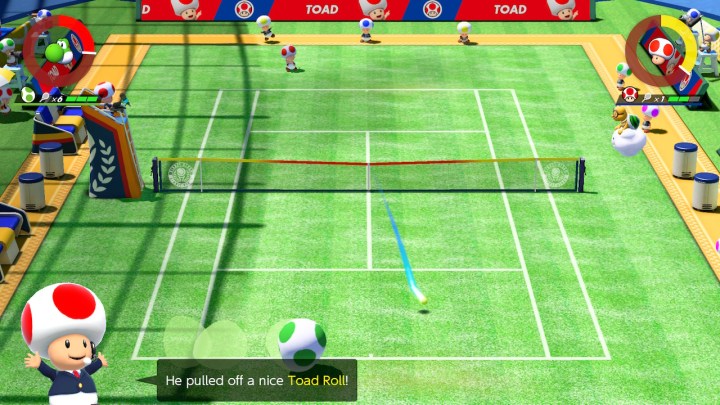
Each character has their own trick shot. Some slide across the court, others jump, and the marvelous Waluigi moonwalks. The end result is the same — a quick movement to get to a hard to reach ball.
If you’re playing against a particularly adept opponent, one that uses every shot in their arsenal, you will need to use trick shots for more than just to block zone shots. This is why it’s beneficial to get comfortable with a character, as in pick a main or two, and practice their trick shots until it becomes a routine part of your game. You’ll need trick shots in both the latter Adventure challenges and when playing against skilled opponents online. Keep in mind that failed trick shots deplete your energy meter, while properly executed ones fill it.
Special shots are cool, but don’t forget the basics

The only shot better than a Zone Shot is the Special Shot which, as mentioned, is only available when your energy meter is full. Special shots have their own animations. They are E-rated Mortal Kombat fatalities.
They are cool, we know, but unless the special shot will directly lead to a game, set, or match win — or stave off losing one of those — be careful using it. It fully depletes your energy bar, which leaves you vulnerable if the Special Shot doesn’t work. Over-eager use of a Special Shot is a quick way to lose, particularly as you face skilled human opponents.
Unless a crucial point is on the line, you’d rather have that energy meter available for zone shots and slow motion. Also remember that you (and your opponent) can block special shots like you do zone shots, although they come in hotter.
Editors' Recommendations
- Sea of Thieves beginner’s guide: 16 tips for new pirates
- Best Nintendo Switch deals: consoles, games, and accessories
- How to get Wild Greens in Zelda: Tears of the Kingdom
- The best horses in The Legend of Zelda: Breath of the Wild
- Unicorn Overlord romance guide: all characters you can marry


